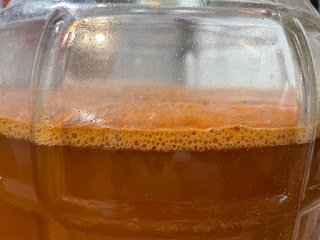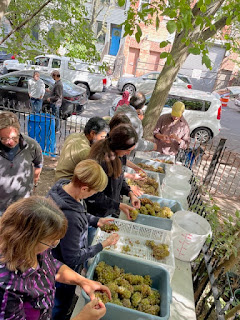Here's some recap and thoughts, running from the grape purchase, through crush day, and then to racking the must off the gross lees.
First, even if whoever you talk to at the grape merchant says you don't need to place an order in advance, do it anyway if you know you have someone to do the driving. Not doing it this year meant we missed out on the Sauv. Blanc grapes that we wanted to work with (though the Muscat C are another wow and another adventure).
Second, because September is nutty busy at the 11th Street homestead and we just don't know very far in advance whether we'll have a Saturday, Sunday, or both for winemaking, we've had a number of years in the last four or five where we brought the grapes down on a Saturday and then worked the wine on a Sunday. But it's good to know that, at least if we're only making white or only making red, there's plenty of time to set up while the grapes are on their three hour drive down from Hartford, then do the crush day work, clean up, and still have a fine feast for the winemakers. This year we even finished the setup a little too early and had an hour of downtime before the grapes arrived.
Third, bring the stomping barrels and primary fermenters up from the cellar at least a few days before crush day, even the weekend before. It seems unavoidable that they come out of the cellar smelling musty. A week of sunshine and fresh air makes a big, big difference to getting them ready to work with.
Fourth, if we're making whites, use two barrels for stomping instead of the one that we used this year and last. That way the sorting and destemming crews don't have to wait and twiddle their thumbs while the stompers and press crews do their thing. At one point this year we must have had at least a half dozen folks just watching the press gang because the operations were all bottlenecked. Doodle doo.
Fifth, do all the yeast research so that expectations are set. I might not have sweated completely filling the 100 liter fermenter if I understood how low-foaming QA23 is.
Sixth, just go ahead and purchase new bubblers every year. It won't break the bank and we won't have to worry whether there's any leftover scuzz in the downspout.
Seventh, either run the big honkin commercial fan in the cellar or consider buying a portable AC unit that can vent out through the back hatch. It would be pretty far out to see if we could keep the cellar 10 degrees cooler and see how that might affect the fermentation. Why? The must tracked the ambient cellar temperature within a one or two degrees farenheit all through the primary.
That's the bulk of it. HUGE THANKS to everyone who had their hands or feet in the grapes this year. It's hard to express what it means to us to have you all here, working, laying the groundwork for the ridiculous June celebration
And here's a little day 10 update.
In the first 8 hours after the transfer to carboys all of the bubblers fouled at least once, but are now clean and gurgling happily. Counterintuitively (to me), the small vessel that had the yeasty bottom of the fermenter poured into it and then became a volcano of foam, is now the quietest of the gang.
Here's what CB 3 of 5 looks like. (And I should really get into the habit of loading the video to Youtube or Vimeo so they are better quality, but... lazy!)




































